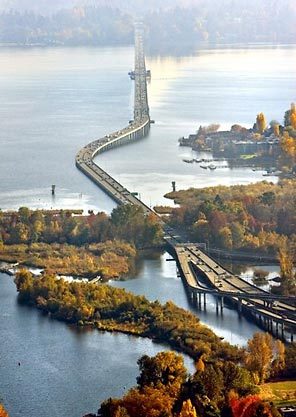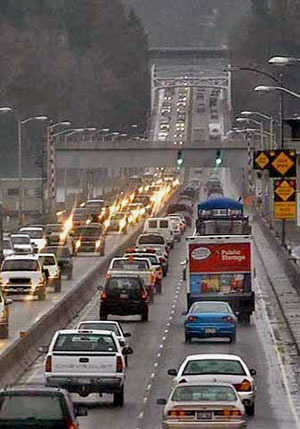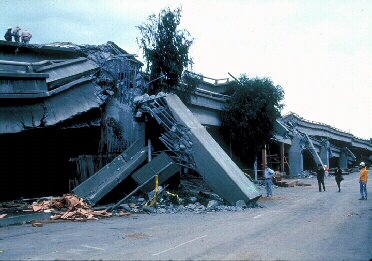FINAL BILL REPORT
ESB 6628
PARTIAL VETO
C 199 L 98
Synopsis as Enacted 6/11/98
Brief Description: Clarifying transportation planning.
Sponsors: Senators Benton, Finkbeiner, Anderson, Zarelli and Schow.
Senate Committee on Transportation
House Committee on Transportation Policy & Budget
Background: In 1993, the Washington State Department of Transportation, in conformance
with federal requirements, was required to develop a statewide multimodal transportation
plan that would ensure the continued mobility of people and good s in a safe, cost-effective
manner. This multimodal plan, commonly known as Washington’s Transportation Plan,
identifies transportation needs for all modes, provides financial targets for the Transportation
Commission, and identifies responsibilities for its implementation. Washington’s
Transportation Plan addresses transportation modes in two broad categories: a state-owned
component and a state-interest component.
The state-owned component guides state investment in state highways, including bicycles and pedestrian facilities, and state ferries. Both the state highways element and the state ferries element are structured to have maintenance, preservation, and improvement programs.
These elements are required to first assess strategies to enhance the operational efficiency
of the existing system before recommending system expansion.
The state-interest component defines the state’s interest in aviation, marine ports and navigation, freight rail, intercity passenger rail, bicycle transportation and pedestrian walkways,and public transportation. The state-interest component is developed in conjunction with the appropriate public and private transportation providers to ensure the state’s interest in these modes is being met. The state-interest component has different program structures,
depending upon the needs and functions of each transportation mode.
Washington’s Transportation Plan(WTP) includes long-range transportation plans and invest-
ment needs for each mode; it does not compare combinations of modal investments within
a state transportation corridor. Comparison between transportation modes is difficult because
of different service objectives, program structures, and funding mechanisms between the
state-owned transportation component and the state-interest transportation component.
In addition, the development of the different transportation components within WTP places
a primary emphasis on the improvement and integration of all transportation modes to create
a seamless intermodal transportation system for people and goods. There is a concern that
WTP does not specifically prioritize congestion relief, the preservation of existing
investments, traveler safety, and the efficient movement of freight and goods. In addition,
there is concern that the state-owned component of WTP does not emphasize congestion
relief within its capacity and operational improvement element.
As part of addressing congestion relief, the Central Puget Sound Regional Transit Authority
(RTA) is proceeding with a ten-year, high capacity transit plan approved by voters in
portions of King, Pierce and Snohomish counties in November 1996. That plan calls for
improvements in regional express bus service, direct access facilities to the high occupancy
vehicle lane system, a commuter rail element, and a light rail transit system.
The RTA-planned system is estimated to cost $3.9 billion in 1995 dollars. This expenditure plan assumes $727 million in federal funds. This total expenditure includes $1.8 billion for light rail and $670 million for commuter rail. Train sets and other rolling stock for these rail services total $160-$200 million for light rail and $120 million for commuter rail.
Federal Transit Administration regulations preclude geographic preferences for grantees’
purchases, except where federal statutes expressly mandate or encourage those preferences.
At present, such preferences could jeopardize federal participation in the RTA project.
Currently, two Talgo train sets are being constructed in Seattle for the state of Washington.
These train sets were funded with state funds, and a condition of any contract let for such
acquisition by the state was that the manufacturer of the trains has the obligation of
establishing a corporate office in Washington State. The manufacturer is also obligated to
spend a minimum of 25 percent of the total purchase price of the train sets on the assembly
and manufacture of parts of the train sets in Washington State.–
Summary: The statewide multimodal transportation plan is directed to place a primary emphasis on congestion relief, the preservation of existing investments, the improvement of traveler safety, and the efficient movement of freight and goods.
The state-owned facilities component of the statewide multimodal transportation plan
(Washington’s Transportation Plan) is required to identify the most cost-effective
combination of highway, ferry, passenger rail, and high-capacity transportation
improvements that maximizes the efficient movement of people, freight, and goods within
state transportation corridors.
The state-owned component, capacity and operational improvement element is directed to
place a primary emphasis on congestion relief. The intercity passenger rail plan, which is a state-interest component of the statewide multimodal plan, is required to include a service preservation element, and a service improvement element. The service preservation element must outline trackage, depots, and train investments needed to maintain and establish service levels. The service improvement element must establish service improvement objectives that outlines the trackage, depot, and train investments needed to meet improvement service objectives.
The RTA is required to consult with the Department of Community, Trade, and Economic
Development to explore the potential for developing contracting methods that encourage
development of a manufacturing base in Washington for commuter and light rail train sets
and components. The RTA must report its findings to the Legislative Transportation
Committee by January 1, 1999.
Votes on Final Passage:
Senate
49 0
House
88 0 (House amended)
Senate
(Senate refused to concur)
House
(House refused to recede)
House
77 21 (House amended)
Senate
48 1 (Senate concurred)
Effective: June 11, 1998
Partial Veto Summary: The requirement for the state-owned facilities component of the
statewide multimodal transportation plan to identify the most cost-effective combination of
highway, ferry, passenger rail, and high capacity transportation improvements that maximize
the efficient movement of people, freight, and goods within transportation corridors is
removed.
The requirement for the state-owned component, capacity and operational improvement element to place a primary emphasis on congestion relief is removed.
The requirement for the intercity passenger rail plan to include a service preservation
element, and a service improvement element is removed
The phrase,'Unsound Transit', was coined by the Wall Street Journal to describe Seattle where,"Light Rail Madness eats billions that could otherwise be devoted to truly efficient transportation technologies." The Puget Sound's traffic congestion is a growing cancer on the region's prosperity. This website, captures news and expert opinion about ways to address the crisis. This is not a blog, but a knowledge base, which collects the best articles and presents them in a searchable format. My goal is to arm residents with knowledge so they can champion fact-based, rather than emotional, solutions.
Transportation
Monday, March 10, 2008
Governor Veto's Congestion Relief Legislation
The articles are posted solely for educational purposes to raise awareness of transportation issues. I claim no authorship, nor do I profit from this website. Where known, all original authors and/or source publisher have been noted in the post. As this is a knowledge base, rather than a blog, I have reproduced the articles in full to allow for complete reader understanding and allow for comprehensive text searching...see custom google search engine at the top of the page. If you have concerns about the inclusion of a specific article, please email bbdc1@live.com. for a speedy resolution.









